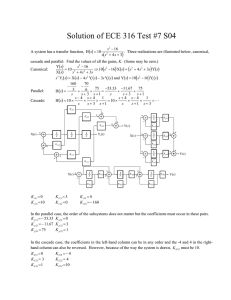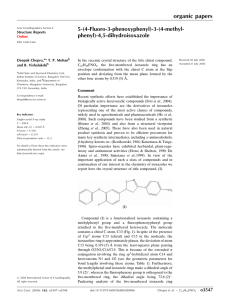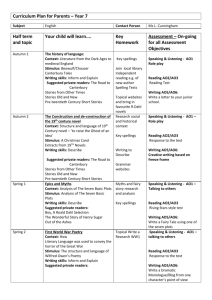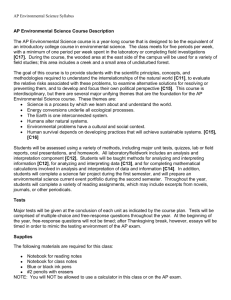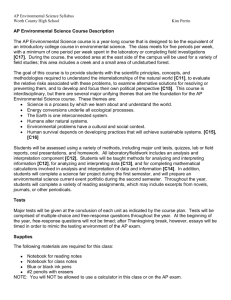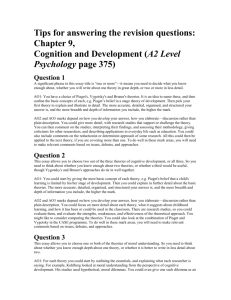Document 13876868
advertisement
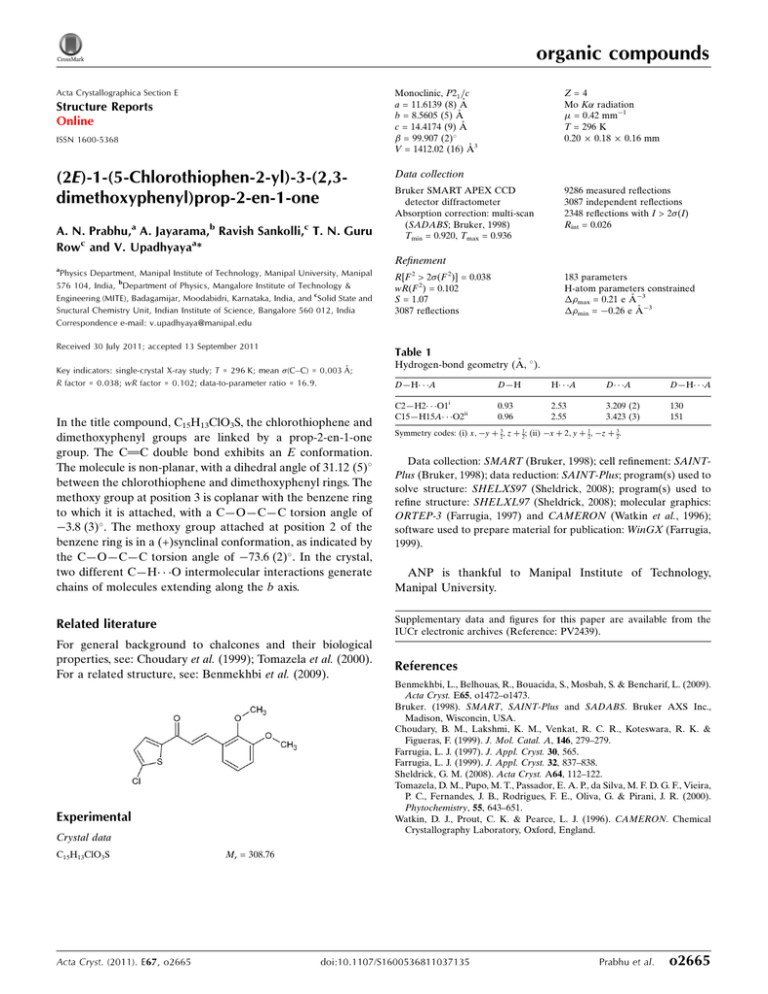
organic compounds Acta Crystallographica Section E Monoclinic, P21 =c a = 11.6139 (8) Å b = 8.5605 (5) Å c = 14.4174 (9) Å = 99.907 (2) V = 1412.02 (16) Å3 Structure Reports Online ISSN 1600-5368 (2E)-1-(5-Chlorothiophen-2-yl)-3-(2,3dimethoxyphenyl)prop-2-en-1-one A. N. Prabhu,a A. Jayarama,b Ravish Sankolli,c T. N. Guru Rowc and V. Upadhyayaa* Z=4 Mo K radiation = 0.42 mm1 T = 296 K 0.20 0.18 0.16 mm Data collection Bruker SMART APEX CCD detector diffractometer Absorption correction: multi-scan (SADABS; Bruker, 1998) Tmin = 0.920, Tmax = 0.936 9286 measured reflections 3087 independent reflections 2348 reflections with I > 2(I) Rint = 0.026 Refinement a Physics Department, Manipal Institute of Technology, Manipal University, Manipal 576 104, India, bDepartment of Physics, Mangalore Institute of Technology & Engineering (MITE), Badagamijar, Moodabidri, Karnataka, India, and cSolid State and Sructural Chemistry Unit, Indian Institute of Science, Bangalore 560 012, India Correspondence e-mail: v.upadhyaya@manipal.edu R[F 2 > 2(F 2)] = 0.038 wR(F 2) = 0.102 S = 1.07 3087 reflections Received 30 July 2011; accepted 13 September 2011 Table 1 Key indicators: single-crystal X-ray study; T = 296 K; mean (C–C) = 0.003 Å; R factor = 0.038; wR factor = 0.102; data-to-parameter ratio = 16.9. 183 parameters H-atom parameters constrained max = 0.21 e Å3 min = 0.26 e Å3 Hydrogen-bond geometry (Å, ). D—H A i C2—H2 O1 C15—H15A O2ii D—H H A D A D—H A 0.93 0.96 2.53 2.55 3.209 (2) 3.423 (3) 130 151 In the title compound, C15H13ClO3S, the chlorothiophene and dimethoxyphenyl groups are linked by a prop-2-en-1-one group. The C C double bond exhibits an E conformation. The molecule is non-planar, with a dihedral angle of 31.12 (5) between the chlorothiophene and dimethoxyphenyl rings. The methoxy group at position 3 is coplanar with the benzene ring to which it is attached, with a C—O—C—C torsion angle of 3.8 (3) . The methoxy group attached at position 2 of the benzene ring is in a (+)synclinal conformation, as indicated by the C—O—C—C torsion angle of 73.6 (2) . In the crystal, two different C—H O intermolecular interactions generate chains of molecules extending along the b axis. Data collection: SMART (Bruker, 1998); cell refinement: SAINTPlus (Bruker, 1998); data reduction: SAINT-Plus; program(s) used to solve structure: SHELXS97 (Sheldrick, 2008); program(s) used to refine structure: SHELXL97 (Sheldrick, 2008); molecular graphics: ORTEP-3 (Farrugia, 1997) and CAMERON (Watkin et al., 1996); software used to prepare material for publication: WinGX (Farrugia, 1999). Related literature Supplementary data and figures for this paper are available from the IUCr electronic archives (Reference: PV2439). For general background to chalcones and their biological properties, see: Choudary et al. (1999); Tomazela et al. (2000). For a related structure, see: Benmekhbi et al. (2009). Crystal data Acta Cryst. (2011). E67, o2665 ANP is thankful to Manipal Institute of Technology, Manipal University. References Benmekhbi, L., Belhouas, R., Bouacida, S., Mosbah, S. & Bencharif, L. (2009). Acta Cryst. E65, o1472–o1473. Bruker. (1998). SMART, SAINT-Plus and SADABS. Bruker AXS Inc., Madison, Wisconcin, USA. Choudary, B. M., Lakshmi, K. M., Venkat, R. C. R., Koteswara, R. K. & Figueras, F. (1999). J. Mol. Catal. A, 146, 279–279. Farrugia, L. J. (1997). J. Appl. Cryst. 30, 565. Farrugia, L. J. (1999). J. Appl. Cryst. 32, 837–838. Sheldrick, G. M. (2008). Acta Cryst. A64, 112–122. Tomazela, D. M., Pupo, M. T., Passador, E. A. P., da Silva, M. F. D. G. F., Vieira, P. C., Fernandes, J. B., Rodrigues, F. E., Oliva, G. & Pirani, J. R. (2000). Phytochemistry, 55, 643–651. Watkin, D. J., Prout, C. K. & Pearce, L. J. (1996). CAMERON. Chemical Crystallography Laboratory, Oxford, England. Experimental C15H13ClO3S Symmetry codes: (i) x; y þ 32; z þ 12; (ii) x þ 2; y þ 12; z þ 32. Mr = 308.76 doi:10.1107/S1600536811037135 Prabhu et al. o2665 supporting information supporting information Acta Cryst. (2011). E67, o2665 [doi:10.1107/S1600536811037135] (2E)-1-(5-Chlorothiophen-2-yl)-3-(2,3-dimethoxyphenyl)prop-2-en-1-one A. N. Prabhu, A. Jayarama, Ravish Sankolli, T. N. Guru Row and V. Upadhyaya S1. Comment Chalcones represent one of the most abundant and ubiquitous group of natural products (Tomazela, et al., 2000). In the past few years, they have been shown to possess interesting biological properties and synthetic intermediates (Choudary, et al., 1999). In the title compound (Fig. 1), the chlorothiophene and dimethoxyphenyl groups are linked by a prop-2en-1-one group. The chlorothiophene and dimethoxyphenyl rings are non-planar with the dihedral angle 31.12 (5)°. The torsion angle C15–O3–C12–C11 is 3.7 (3)° indicating that the O3 methoxy group is coplanar with the attached benzene ring. The other methoxy group at O2 is in a + synclinal conformation as indicated by the torsion angle 73.6 (2)° for C14– O2–C13–C12. The C═C double bond exhibits an E conformation (Benmekhbi, et al., 2009). The crystal structure is stabilized by two different C—H···O intermolecular interactions generating chains of molecules along the b-axis (Fig. 2). S2. Experimental To synthesizethe the title compound, 2-acetyl-5-chlorothiophene (0.01 mol) and 2,3-dimethoxybenzaldehyde (0.01 mol) were dissolved in methanol (60 ml). Sodium hydroxide (5 ml, 20%) was then added drop wise to the solution, and it was stirred for 2 h. The contents of the flask were poured into ice-cold water, and the resulting crude solid was collected by filtration. The compound was dried and re-crystallized twice from acetone. S3. Refinement The H atoms were placed at calculated positions in the riding model approximation with C—H = 0.93 and 0.96 Å, for aryl and methyl H-atoms, respectively, with Uiso(H) = 1.2 and 1.5Ueq(C). Acta Cryst. (2011). E67, o2665 sup-1 supporting information Figure 1 ORTEP (Farrugia, 1997) view of the title compound, showing 50% probability ellipsoids and the atom numbering scheme. Figure 2 A unit cell packing of the title compound showing intermolecular interactions with dotted lines. H-atoms not involved in hydrogen bonding have been excluded for clarity. Acta Cryst. (2011). E67, o2665 sup-2 supporting information (2E)-1-(5-Chlorothiophen-2-yl)-3-(2,3-dimethoxyphenyl)prop-2-en-1-one Crystal data C15H13ClO3S Mr = 308.76 Monoclinic, P21/c Hall symbol: -P 2ybc a = 11.6139 (8) Å b = 8.5605 (5) Å c = 14.4174 (9) Å β = 99.907 (2)° V = 1412.02 (16) Å3 Z=4 F(000) = 640 Dx = 1.452 Mg m−3 Mo Kα radiation, λ = 0.71073 Å Cell parameters from 3087 reflections θ = 1.8–27.0° µ = 0.42 mm−1 T = 296 K Block, yellow 0.20 × 0.18 × 0.16 mm Data collection Bruker SMART APEX CCD detector diffractometer Radiation source: fine-focus sealed tube Graphite monochromator ω scans Absorption correction: multi-scan (SADABS; Bruker, 1998) Tmin = 0.920, Tmax = 0.936 9286 measured reflections 3087 independent reflections 2348 reflections with I > 2σ(I) Rint = 0.026 θmax = 27.0°, θmin = 1.8° h = −14→14 k = −8→10 l = −18→14 Refinement Refinement on F2 Least-squares matrix: full R[F2 > 2σ(F2)] = 0.038 wR(F2) = 0.102 S = 1.07 3087 reflections 183 parameters 0 restraints Primary atom site location: structure-invariant direct methods Secondary atom site location: difference Fourier map Hydrogen site location: inferred from neighbouring sites H-atom parameters constrained w = 1/[σ2(Fo2) + (0.0494P)2 + 0.1854P] where P = (Fo2 + 2Fc2)/3 (Δ/σ)max = 0.001 Δρmax = 0.21 e Å−3 Δρmin = −0.26 e Å−3 Special details Geometry. All s.u.'s (except the s.u. in the dihedral angle between two l.s. planes) are estimated using the full covariance matrix. The cell s.u.'s are taken into account individually in the estimation of s.u.'s in distances, angles and torsion angles; correlations between s.u.'s in cell parameters are only used when they are defined by crystal symmetry. An approximate (isotropic) treatment of cell s.u.'s is used for estimating s.u.'s involving l.s. planes. Refinement. Refinement of F2 against ALL reflections. The weighted R-factor wR and goodness of fit S are based on F2, conventional R-factors R are based on F, with F set to zero for negative F2. The threshold expression of F2 > 2σ(F2) is used only for calculating R-factors(gt) etc. and is not relevant to the choice of reflections for refinement. R-factors based on F2 are statistically about twice as large as those based on F, and R- factors based on ALL data will be even larger. Fractional atomic coordinates and isotropic or equivalent isotropic displacement parameters (Å2) Cl1 S1 O1 O2 x y z Uiso*/Ueq 0.22862 (5) 0.33583 (4) 0.46583 (12) 0.80027 (11) 0.40719 (7) 0.57846 (6) 0.75106 (18) 0.99907 (15) 1.17836 (4) 1.03539 (3) 0.91191 (10) 0.81682 (8) 0.06157 (19) 0.04070 (15) 0.0540 (4) 0.0413 (3) Acta Cryst. (2011). E67, o2665 sup-3 supporting information O3 C1 C2 H2 C3 H3 C4 C5 C6 H6 C7 H7 C8 C9 H9 C10 H10 C11 H11 C12 C13 C14 H14C H14B H14A C15 H15C H15A H15B 0.97557 (11) 0.33815 (16) 0.43004 (17) 0.4440 0.50212 (16) 0.5697 0.46355 (14) 0.51284 (15) 0.61819 (15) 0.6442 0.67724 (15) 0.6509 0.77860 (15) 0.82092 (16) 0.7857 0.91330 (17) 0.9406 0.96713 (16) 1.0293 0.92801 (15) 0.83426 (15) 0.73927 (19) 0.6614 0.7358 0.7796 1.0673 (2) 1.0407 1.0896 1.1334 1.20940 (17) 0.5228 (2) 0.5799 (2) 0.5608 0.6722 (2) 0.7210 0.6834 (2) 0.7641 (2) 0.8604 (2) 0.8791 0.9214 (2) 0.8949 1.0250 (2) 1.0873 (2) 1.0592 1.1886 (3) 1.2280 1.2336 (2) 1.3036 1.1742 (2) 1.0682 (2) 1.0981 (3) 1.1159 1.0488 1.1960 1.3220 (3) 1.4174 1.3416 1.2829 0.83929 (10) 1.14971 (13) 1.21037 (13) 1.2748 1.16311 (13) 1.1936 1.06827 (12) 0.99432 (13) 1.02313 (13) 1.0868 0.96006 (13) 0.8975 0.97828 (12) 1.06805 (13) 1.1188 1.08140 (14) 1.1413 1.00634 (14) 1.0161 0.91742 (13) 0.90333 (12) 0.74504 (15) 0.7566 0.6848 0.7454 0.84993 (18) 0.8742 0.7899 0.8929 0.0509 (4) 0.0387 (4) 0.0451 (5) 0.054* 0.0427 (5) 0.051* 0.0358 (4) 0.0384 (4) 0.0407 (4) 0.049* 0.0382 (4) 0.046* 0.0357 (4) 0.0431 (5) 0.052* 0.0485 (5) 0.058* 0.0466 (5) 0.056* 0.0396 (4) 0.0347 (4) 0.0540 (6) 0.081* 0.081* 0.081* 0.0660 (7) 0.099* 0.099* 0.099* Atomic displacement parameters (Å2) Cl1 S1 O1 O2 O3 C1 C2 C3 C4 C5 C6 C7 C8 C9 C10 U11 U22 U33 U12 U13 U23 0.0603 (3) 0.0417 (3) 0.0592 (8) 0.0537 (7) 0.0484 (8) 0.0436 (10) 0.0542 (11) 0.0438 (10) 0.0362 (9) 0.0405 (9) 0.0443 (10) 0.0438 (10) 0.0373 (9) 0.0453 (10) 0.0472 (11) 0.0672 (4) 0.0445 (3) 0.0645 (10) 0.0392 (8) 0.0632 (10) 0.0360 (10) 0.0497 (13) 0.0453 (12) 0.0339 (10) 0.0382 (11) 0.0441 (11) 0.0370 (11) 0.0365 (10) 0.0518 (13) 0.0616 (14) 0.0591 (4) 0.0344 (3) 0.0361 (8) 0.0328 (7) 0.0446 (8) 0.0382 (10) 0.0315 (9) 0.0374 (10) 0.0377 (10) 0.0370 (10) 0.0343 (10) 0.0349 (9) 0.0339 (9) 0.0333 (9) 0.0350 (10) −0.0213 (3) −0.00324 (19) −0.0086 (7) 0.0012 (6) −0.0134 (7) −0.0011 (8) −0.0044 (9) −0.0059 (8) 0.0025 (7) 0.0060 (8) −0.0009 (8) 0.0048 (8) 0.0061 (7) 0.0036 (9) 0.0001 (10) 0.0158 (3) 0.00221 (18) 0.0025 (6) 0.0124 (6) 0.0174 (6) 0.0122 (8) 0.0074 (8) 0.0026 (8) 0.0078 (7) 0.0084 (8) 0.0087 (8) 0.0101 (8) 0.0078 (7) 0.0100 (8) 0.0019 (8) 0.0057 (3) 0.0015 (2) 0.0093 (7) −0.0022 (6) 0.0012 (7) 0.0004 (8) −0.0008 (9) −0.0015 (9) −0.0004 (8) 0.0046 (8) 0.0013 (8) 0.0029 (8) 0.0024 (8) 0.0032 (9) −0.0040 (9) Acta Cryst. (2011). E67, o2665 sup-4 supporting information C11 C12 C13 C14 C15 0.0388 (10) 0.0374 (9) 0.0381 (9) 0.0607 (13) 0.0583 (13) 0.0536 (13) 0.0438 (12) 0.0337 (10) 0.0573 (14) 0.0776 (18) 0.0462 (12) 0.0394 (10) 0.0332 (9) 0.0412 (11) 0.0665 (16) −0.0048 (8) 0.0033 (8) 0.0049 (7) 0.0048 (10) −0.0211 (12) 0.0042 (8) 0.0116 (8) 0.0083 (7) 0.0009 (9) 0.0230 (11) −0.0020 (10) 0.0039 (9) −0.0010 (8) 0.0042 (10) 0.0056 (13) Geometric parameters (Å, º) Cl1—C1 S1—C1 S1—C4 O1—C5 O2—C13 O2—C14 O3—C12 O3—C15 C1—C2 C2—C3 C2—H2 C3—C4 C3—H3 C4—C5 C5—C6 C6—C7 C6—H6 1.7173 (19) 1.7115 (19) 1.7292 (18) 1.224 (2) 1.376 (2) 1.428 (2) 1.371 (2) 1.425 (2) 1.350 (3) 1.409 (3) 0.9300 1.367 (2) 0.9300 1.467 (2) 1.474 (3) 1.336 (3) 0.9300 C7—C8 C7—H7 C8—C13 C8—C9 C9—C10 C9—H9 C10—C11 C10—H10 C11—C12 C11—H11 C12—C13 C14—H14C C14—H14B C14—H14A C15—H15C C15—H15A C15—H15B 1.461 (3) 0.9300 1.401 (2) 1.408 (3) 1.367 (3) 0.9300 1.394 (3) 0.9300 1.381 (3) 0.9300 1.405 (3) 0.9600 0.9600 0.9600 0.9600 0.9600 0.9600 C1—S1—C4 C13—O2—C14 C12—O3—C15 C2—C1—S1 C2—C1—Cl1 S1—C1—Cl1 C1—C2—C3 C1—C2—H2 C3—C2—H2 C4—C3—C2 C4—C3—H3 C2—C3—H3 C3—C4—C5 C3—C4—S1 C5—C4—S1 O1—C5—C4 O1—C5—C6 C4—C5—C6 C7—C6—C5 C7—C6—H6 C5—C6—H6 C6—C7—C8 90.57 (9) 115.51 (15) 117.37 (17) 113.76 (14) 126.07 (15) 120.16 (11) 111.04 (17) 124.5 124.5 113.79 (17) 123.1 123.1 131.18 (17) 110.84 (14) 117.97 (13) 119.86 (17) 122.29 (18) 117.85 (16) 121.68 (17) 119.2 119.2 127.37 (18) C10—C9—C8 C10—C9—H9 C8—C9—H9 C9—C10—C11 C9—C10—H10 C11—C10—H10 C12—C11—C10 C12—C11—H11 C10—C11—H11 O3—C12—C11 O3—C12—C13 C11—C12—C13 O2—C13—C8 O2—C13—C12 C8—C13—C12 O2—C14—H14C O2—C14—H14B H14C—C14—H14B O2—C14—H14A H14C—C14—H14A H14B—C14—H14A O3—C15—H15C 120.74 (18) 119.6 119.6 120.79 (18) 119.6 119.6 119.92 (19) 120.0 120.0 124.53 (17) 115.79 (16) 119.67 (17) 119.14 (16) 120.23 (16) 120.53 (17) 109.5 109.5 109.5 109.5 109.5 109.5 109.5 Acta Cryst. (2011). E67, o2665 sup-5 supporting information C6—C7—H7 C8—C7—H7 C13—C8—C9 C13—C8—C7 C9—C8—C7 116.3 116.3 118.32 (17) 119.08 (16) 122.57 (17) O3—C15—H15A H15C—C15—H15A O3—C15—H15B H15C—C15—H15B H15A—C15—H15B 109.5 109.5 109.5 109.5 109.5 C4—S1—C1—C2 C4—S1—C1—Cl1 S1—C1—C2—C3 Cl1—C1—C2—C3 C1—C2—C3—C4 C2—C3—C4—C5 C2—C3—C4—S1 C1—S1—C4—C3 C1—S1—C4—C5 C3—C4—C5—O1 S1—C4—C5—O1 C3—C4—C5—C6 S1—C4—C5—C6 O1—C5—C6—C7 C4—C5—C6—C7 C5—C6—C7—C8 C6—C7—C8—C13 C6—C7—C8—C9 0.09 (17) 179.16 (12) −0.1 (2) −179.14 (15) 0.1 (3) −178.76 (19) −0.1 (2) −0.02 (15) 178.87 (15) 176.0 (2) −2.6 (2) −4.6 (3) 176.79 (13) −9.3 (3) 171.31 (17) 176.47 (17) 175.42 (18) −6.5 (3) C13—C8—C9—C10 C7—C8—C9—C10 C8—C9—C10—C11 C9—C10—C11—C12 C15—O3—C12—C11 C15—O3—C12—C13 C10—C11—C12—O3 C10—C11—C12—C13 C14—O2—C13—C8 C14—O2—C13—C12 C9—C8—C13—O2 C7—C8—C13—O2 C9—C8—C13—C12 C7—C8—C13—C12 O3—C12—C13—O2 C11—C12—C13—O2 O3—C12—C13—C8 C11—C12—C13—C8 0.6 (3) −177.48 (18) 0.5 (3) −0.8 (3) −3.8 (3) 177.16 (18) −179.22 (18) −0.2 (3) 109.94 (19) −73.6 (2) 174.84 (15) −7.0 (2) −1.6 (3) 176.61 (16) 4.1 (3) −175.02 (16) −179.52 (16) 1.4 (3) Hydrogen-bond geometry (Å, º) D—H···A i C2—H2···O1 C15—H15A···O2ii D—H H···A D···A D—H···A 0.93 0.96 2.53 2.55 3.209 (2) 3.423 (3) 130 151 Symmetry codes: (i) x, −y+3/2, z+1/2; (ii) −x+2, y+1/2, −z+3/2. Acta Cryst. (2011). E67, o2665 sup-6
